Have you ever walked into a kindergarten and felt the warmth, creativity and inspiration? Do you want to know how to create your own creative kindergarten classroom? Do you know any wonderful preschool classroom decorations?
Designing preschool classroom decorations is all about finding the perfect balance. It’s about creating a space that sparks curiosity, inspires learning, and feels welcoming without overstimulating young minds. From selecting calming yet cheerful color palettes to adding playful, interactive elements, every decoration plays an important role in shaping a child’s daily learning experience.
In this guide, you’ll find practical ideas, color inspirations, and decoration themes tailored for preschool settings. From wall displays to reading corners, we’ll explore how every detail can support children’s learning and emotional well-being — without overwhelming your classroom.
유치원 교실 장식이 중요한 이유는 무엇일까요?
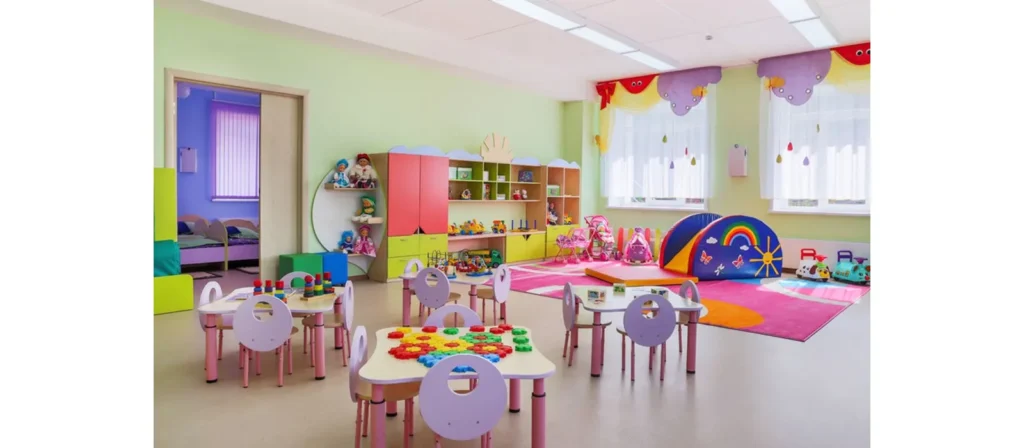
교실 설계의 심리적 영향
Research suggests that colors, spatial organization, and visual stimuli significantly impact children’s learning abilities and emotional well-being. Bright, warm colors can energize children, while soft pastels promote calmness and focus. Defined spaces within the classroom provide structure and help children transition smoothly between activities.
시각적 자극을 통한 학습 촉진
Children in their early years learn best through sensory experiences. Thoughtfully designed preschool classroom decorations, including educational posters, themed displays, and hands-on interactive elements, help reinforce learning concepts and encourage exploration.
사회적, 정서적 성장 촉진
A well-decorated classroom supports not just academics but also social and emotional development. Displays that celebrate student achievements, diversity, and teamwork foster a sense of pride and inclusivity among children.
15 Preschool Classroom Decoration Ideas
Below are the 15 core ideas with practical guidance. Some entries include short project plans, supply lists, or implementation steps. You don’t need to implement every idea at once; pick the ones that match your program’s goals, space, and children’s needs.
1. Create a Calming Environment
One of the first and most critical decorating decisions is setting the emotional tone of a classroom. Preschoolers thrive when the environment feels safe, predictable, and warm. Instead of overwhelming every wall with bold colors or every ceiling with dangling mobiles, aim for visual balance. Research indicates that classrooms with excessive visual stimulation can actually hinder attention and learning: in one study, children in heavily decorated rooms were off‑task significantly more than in sparsely decorated spaces.
- Choose a restrained palette. Pick two base tones and a bright accent used sparingly. For example: warm cream, sage green, and sunflower yellow accents. Use these across rugs, baskets, and bulletin borders.
- Designate quiet zones. Use a soft rug and low canopy to define a reading/calm area. Keep that area free from high‑contrast posters or flashing lights.
- Limit visual clutter. Opt for a few meaningful displays instead of covering every wall. Leave “negative space” — blank wall sections that reduce visual noise and let children rest their eyes.
- Lighting choices. Use diffused light — sheer curtains for windows and a soft lamp in the calm corner. Avoid direct harsh fluorescent lighting over the entire gathering area.
2. Decorate a Reading Area
A classroom without a dedicated reading space is like a library without shelves. Reading corners are not just functional—they’re emotional havens for preschoolers. A cozy, well-decorated reading area can promote literacy, build emotional security, and foster independent exploration.
Use soft seating like beanbags or small armchairs. Install low bookshelves so children can access books on their own. Then add thematic wall décor that matches current reading topics—jungle animals, fairy tales, outer space.
You can also include:
- Hanging mobiles with letters or characters
- Cushioned rugs with alphabet patterns
- Simple fabric canopies to create a “nook” feeling
If you have windows nearby, add light curtains to filter natural light and prevent distractions. The goal is to make this area inviting and slightly enclosed.
3. Decorate the Classroom with Kids’ Art
Displaying children’s creations increases motivation, builds identity, and makes the classroom feel like a shared community. It’s high‑impact, low‑cost décor that showcases learning processes, not just final products.
- Rotating gallery walls with framed student pieces
- A clothesline with clips to hang paintings
- Laminated drawings with each child’s name below
Make sure art is hung at the child’s eye level. You’re not just creating décor—you’re building self-esteem. It’s also a subtle classroom management tool. When children feel proud of their environment, they’re more likely to care for it.
4. Ideas for Bulletin Boards
Bulletin boards can be decorative, functional, and instructional all at once. They’re not just placeholders—they’re storytelling spaces. With thoughtful design, bulletin boards can support themes, showcase learning progress, and communicate important information.
- Monthly themes like seasons, community helpers, or holidays
- Student portfolios with writing samples or artwork
- Behavioral charts using positive reinforcement visuals
- Letter/Number of the week boards
Keep your boards interactive when possible. Add Velcro elements, flip panels, or spaces for student input. The more children can manipulate or engage with the board, the better.
Limit yourself to one or two major bulletin boards in the classroom, and keep the rest of the wall space calm and breathable.
5. Fun Birthday Displays
Celebrating birthdays in preschool is a great decorating opportunity. it builds community, acknowledges each child, and adds joy. But it’s important to balance fun with focus and inclusivity. But instead of generic, store-bought birthday posters, make your display personal and meaningful.
- A “birthday train” with each child’s photo in a train car
- A cupcake wall with children’s names and birthday dates
- A simple timeline with month headers and child-made icons
- Use a consistent format and color scheme to create continuity.
6. Design a Visual Schedule Board
Young children thrive on routine. When they can see what’s coming next, they feel more in control—and less anxious. A visual schedule board shows the daily routine in pictures and words. You can attach visuals with Velcro or magnets to move them around.
Images with short word labels are suitable for emerging readers and older children. Post the schedule near the door or gathering area for easy reference each morning. Choose a location near a transition (e.g., entryway, carpeted area) and at children’s eye level.
7. Decorate with a Welcome Banner
The first thing children see when they enter the classroom matters. A welcome banner can immediately establish a positive tone for the day.
Avoid overly flashy, generic “WELCOME!” signs. Instead:
- Use multi-language greetings to reflect classroom diversity
- Incorporate student photos or self-portraits
- Use themes like rainbows, trees, or sunshine to make it cheerful
You can involve children in making the banner. This increases their connection to the space and helps transition them into the learning environment from the very first step through the door.
8. Decorate the Classroom Door
The classroom door is an everyday canvas. Use it to reflect your classroom identity, themes, or even seasonal topics. With thoughtful decoration, it can become an extension of your classroom identity and a daily point of engagement.
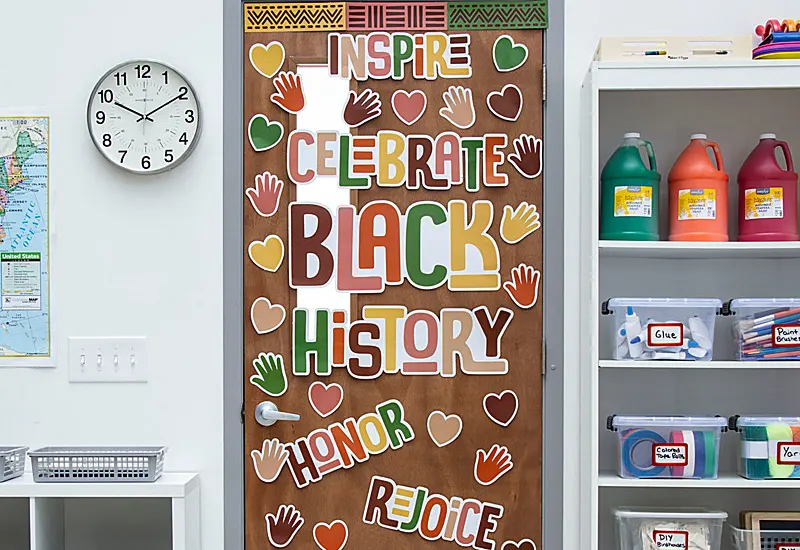
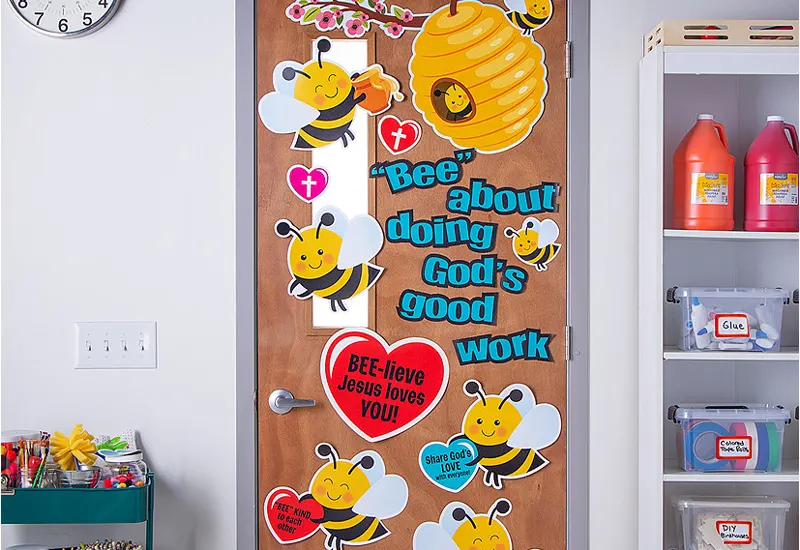
Ideas include:
- A “Who’s in Our Class?” door with children’s names and pictures
- A “Reading Adventure Starts Here” design for literacy-focused classrooms
- Seasonal or thematic displays like autumn leaves or space missions
9. Decorate the Windows and Ceiling
Many preschool teachers overlook the vertical space in the classroom. But the ceiling and windows are key visual elements in a child’s world. When decorated thoughtfully, they can bring warmth and depth to the classroom atmosphere.
Try these ideas:
- Paper lanterns or hanging pom-poms in thematic colors
- Mobiles representing seasons, numbers, or classroom mascots
- Window decals of animals, weather, or shapes
Be sure to balance visibility with safety. For windows, keep visibility clear at adult eye level but add designs at child height to make it engaging for them.
10. Use Rugs and Mats to Create Learning Areas
Floor decorations aren’t always visible. They’re also functional zones. Use rugs and mats to divide space and set behavioral expectations. Choose materials that are non-slip, easy to clean, and sized correctly for your classroom layout. Always opt for neutral or primary color schemes that match the overall classroom tone—not neon chaos.
11. DIY Wall Decor
DIY wall decorations are one of the most effective ways to bring personality and heart into your preschool classroom—without sacrificing budget or originality. Unlike store-bought posters that quickly become background noise, DIY décor invites participation, creativity, and connection.
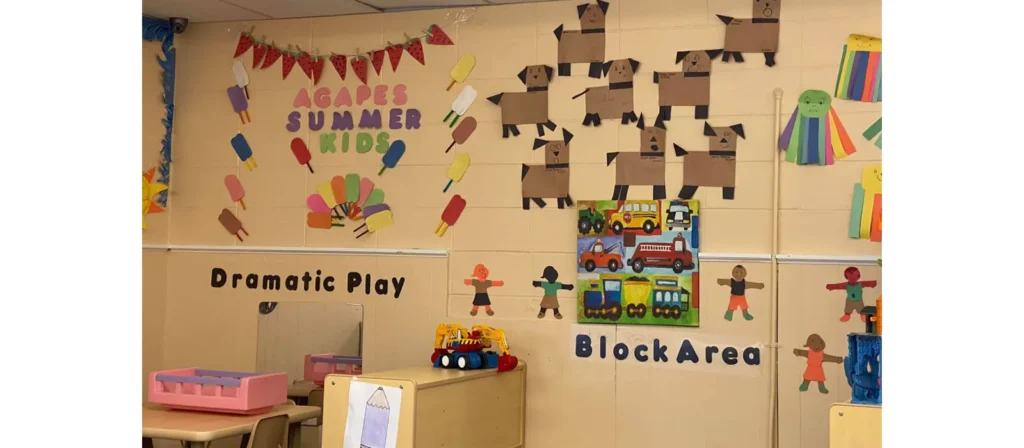
Here are DIY wall décor ideas:
- Create a “handprint tree” where each child adds their painted handprint as a leaf—then use it to track growth or seasons.
- Make a fabric or felt “learning journey” banner where children add personalized icons (e.g., “I learned to write my name,” “I counted to 20”).
- Use recycled magazine or paper scraps to create a colourful mosaic of shapes for a math wall.
- Use string and clothespins across a wall to display children’s current work.
- Have children help cut large letters or shapes for thematic walls and then allow them to place or arrange the pieces themselves.
- Laminate key visuals you use often so they last longer and can be reused year after year.
12. Creative Decorative Objects
While walls, boards, and rugs set the tone, the small decorative objects around your classroom are what give it warmth, depth, and storytelling. These elements should be intentional—not clutter—and always child-safe.
Classroom Mascots
Use a plush toy, puppet, or character figure as a “classroom mascot.” This character can sit on a shelf, participate in circle time, and even have its own name and backstory. It becomes a beloved member of the group and offers continuity.
Thematic Tabletop Displays
Create small decorative setups for the season or unit theme. For example:
- A basket of fall leaves, pinecones, and tiny pumpkins
- A globe, astronaut doll, and stars for space week
- Dinosaurs and faux fossils during a prehistoric unit
Keep these displays simple and child-accessible, using them to spark curiosity and discussion.
Repurposed Natural Materials
Use wooden bowls, stones, shells, or driftwood as both décor and manipulatives. They add texture and a sensory element to the environment, aligning well with Reggio and Montessori principles.
Family Photo Walls or Frames
A small corner with framed family photos helps create emotional security and connection. Each child can bring a family photo to display. This humanizes the room and helps children feel grounded.
Don’t overdo it—just a few key messages placed meaningfully can have a big impact.
13. Name Tags and Personalized Spaces
Personalization in the classroom helps each child feel valued and visible. At this developmental stage, children are forming a sense of identity, and seeing their name and picture on their cubby, seat, or project folder affirms their belonging in the classroom.
Name tags should be simple, clear, and easy to recognize. Ideally, they include the child’s name in large print alongside a visual cue, like a photo or a symbol. This helps children who are still developing literacy skills quickly locate their belongings. Teachers can even involve students in designing their own labels, giving them a sense of ownership and a creative opportunity to express themselves.
These personalized elements can extend beyond cubbies and tables. Mailboxes, supply bins, art drying racks, and classroom job charts can all be labeled with children’s names.
14. Music and Sound as Part of the Decor
While not visual, acoustic decorations can deeply influence the classroom atmosphere. Incorporating soft music, sound centers, or even musical instrument walls can enhance mood and support auditory learning.
Design ideas:
- A hanging bell wall where children can gently ring chimes
- A music corner with soft drums, maracas, or xylophones
- Background classical or nature soundtracks played during quiet time
Sound should be soothing, not overstimulating. Just like color and light, sound is an environmental tool that shapes behavior.
15. Reuse and Use Old Materials for Decorating
One of the most practical, sustainable, and creative decorating strategies is repurposing and reusing materials. This fosters resourcefulness, reduces cost, and often generates richer student‑centered décor.
Preschool decorating doesn’t need to strain your budget. Some of the most creative classroom spaces I’ve seen used entirely upcycled and repurposed materials.
- Turning old T-shirts into wall banners
- Using scrap fabric to create hanging flags
- Repurposing cardboard into student art canvases
- Framing sections of newspaper or old picture books
유치원 교실 장식 고려 사항
Decorating a preschool classroom may seem like a simple task, but in reality, it requires thoughtful consideration, strategic planning, and a strong understanding of child development. An effective preschool classroom should be colorful and cheerful, yes—but also functional, safe, and developmentally appropriate. Every visual element you introduce into the space should serve a purpose: to support learning, reinforce routines, build a sense of community, or encourage independence.

1. Use Bright Colors
Bright colors capture attention and create excitement. Young children are naturally drawn to vivid hues, and the right color palette can stimulate learning, reinforce themes, and differentiate classroom zones. However, the use of color should be intentional. Too much brightness everywhere can cause visual clutter and overstimulation.
2. Keep It at Eye Level
Since preschoolers spend most of their day sitting, playing, and walking close to the floor, decorations should be placed at their eye level. This helps children engage more meaningfully with visual aids, thematic displays, and instructional signage. It also fosters independence.
3. Keep Children Involved
When children help create or choose classroom decorations, they feel a sense of ownership and belonging. It fosters confidence and builds classroom community. Their contributions also reflect real learning and personal expression, making the décor more meaningful than store-bought posters.
4. Stay Organized
Young children rely heavily on structure. When decorations are messy or overdone, they blur those boundaries and confuse behavioral cues. Keeping things orderly doesn’t mean dull. It means that every visual element has a purpose, and everything has a place. Organized décor supports calmness, reduces conflict, and builds a productive learning environment where children feel secure.
5. Use Safe Materials
Safety should never be compromised in favor of aesthetics. All décor must be made from non-toxic, age-appropriate, and durable materials. Safety concerns include choking hazards, sharp edges, or flammable items. Ensuring all materials meet health and safety standards protects both children and staff, reducing risk during daily activities.
6. Keep Safety in Mind
Beyond material safety, decoration placement affects visibility, traffic flow, and emergency access. Hanging décor must be secure, exits must remain clear, and walkways must be free of tripping hazards. Designing with safety in mind prevents accidents and supports smooth classroom operations.
7. Choose the Right Furniture
Classroom decoration doesn’t start with posters and streamers—it starts with furniture. The layout, color, height, and placement of your tables, chairs, cubbies, and shelving units all play a role in how the classroom feels and functions.



- Select age‑appropriate furniture: Child‑sized tables, chairs, shelves at reachable heights.
- Consider flexible furniture: Pieces that can move easily or reconfigure support dynamic décor zones and seasonal changes.
- Furniture should serve dual purposes: For example, bookcases that display books cover‑out, or low cabinets with decorative tops to define zones and display children’s work.
- Matches the decor: Consistent finishes, clean lines, minimal patterns help décor and furniture feel unified.
- Durability and maintenance: Furniture for preschoolers must withstand active use, spills, and be easy to clean and rearrange.
문의 사항이나 견적 요청이 있으시면 메시지를 보내주세요. 저희 전문가가 48시간 이내에 답변해 드리고, 원하시는 제품을 선택하실 수 있도록 도와드리겠습니다.
8. Remember to Change Your Decor
Children thrive on novelty and seasonal rhythms. Updating classroom decorations throughout the year keeps the environment stimulating and relevant. Whether it’s monthly bulletin boards, seasonal themes, or rotating student artwork, a changing environment supports curiosity and engagement. It also reinforces concepts like time, transitions, and cycles. However, changes should be predictable and structured—not random. A consistent update schedule helps children anticipate change and adjust comfortably. Planning décor updates alongside curriculum themes is the most effective approach.
9. Control Your Budget
A well-decorated classroom doesn’t have to break the bank. Reusing materials, incorporating student artwork, and DIY projects can achieve meaningful, personalized décor without excessive spending. Budget-friendly choices also model sustainability and creative problem-solving for children.
How to Decorate Spaces with Different Functions?
잘 정돈된 교실에는 다양한 활동을 위한 공간이 명확하게 구분되어 있어야 합니다. 이러한 공간은 아이들이 특정 활동이 어디에서 이루어지는지 이해하고 하루 종일 원활하게 활동할 수 있도록 도와줍니다.
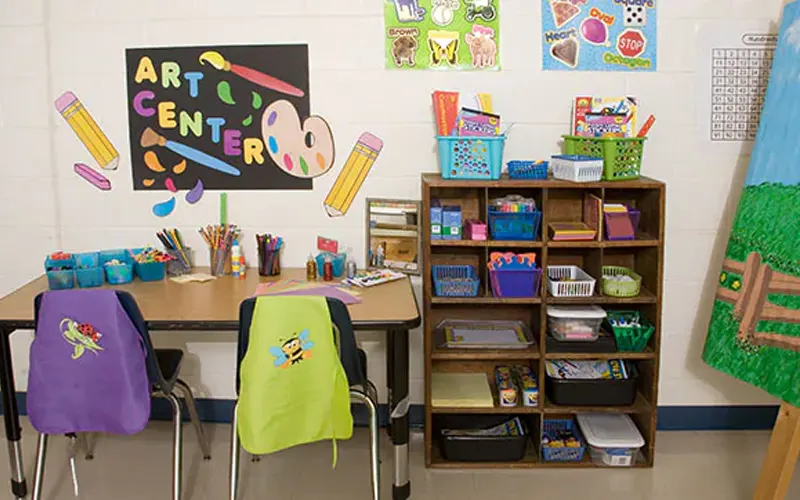
유치원 미술 센터
안 아트 센터 창의력과 자기표현력을 키우는 데 필수품입니다. 크레파스, 물감, 재활용 공예 용품 등 아이들이 사용하기 좋은 재료를 채워주세요. 다채로운 벽면 장식과 건조대를 활용하여 학생들의 작품을 전시하고, 영감을 주는 동시에 실용적인 공간을 만들어 보세요.
미취학아동 과학 센터
실습 과학 센터 호기심과 탐구심을 자극합니다. 돋보기, 감각통, 간단한 실험 도구를 준비해 보세요. 자연, 행성, 인체 포스터는 유치원 교실을 꾸미는 데 도움이 되며, 아이들이 질문하고 탐구하도록 유도할 수 있습니다.
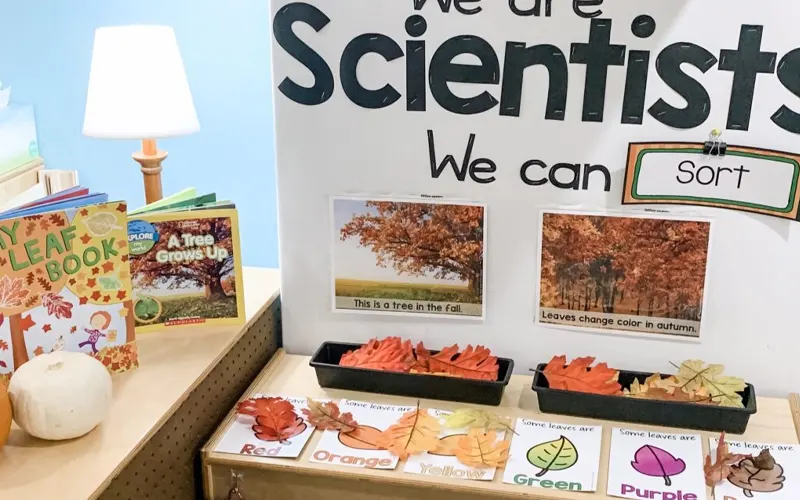
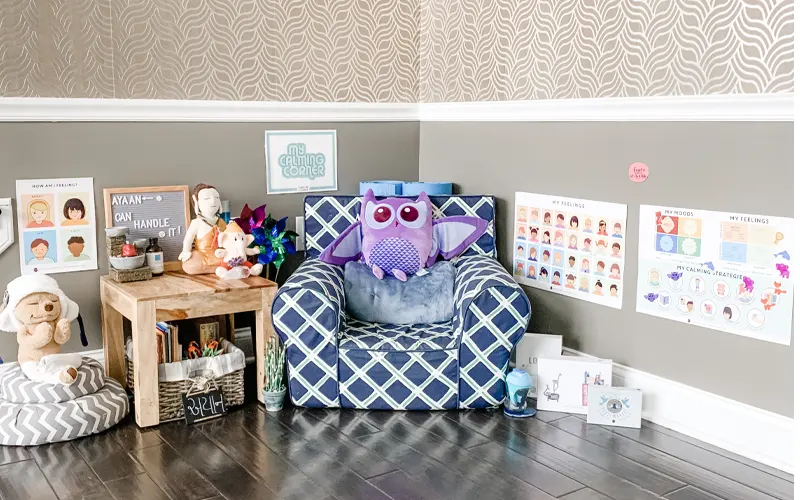
진정 코너
에이 차분한 코너 아이들이 스스로 감정을 조절하고 조절하는 데 도움이 됩니다. 부드러운 좌석, 차분한 색상, 그리고 피젯 장난감이나 무게 담요와 같은 감각적인 요소를 활용하세요. 별이 빛나는 하늘 캐노피나 은은한 조명과 같은 자연 테마의 장식을 추가하면 공간이 더욱 차분해질 수 있습니다.
교실 독서 코너
아늑한 독서 공간 책에 대한 애정을 북돋아 줍니다. 읽기 쉬운 그림책으로 선반을 정리하고, 편안함을 위해 빈백이나 쿠션을 추가하고, 알파벳 포스터나 스토리텔링 테마의 벽 스티커로 장식하여 매력적인 문학 공간을 만들어 보세요.
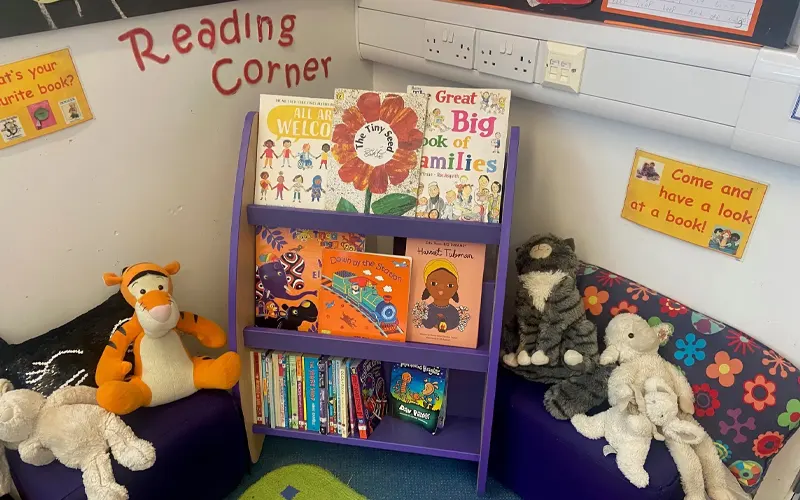
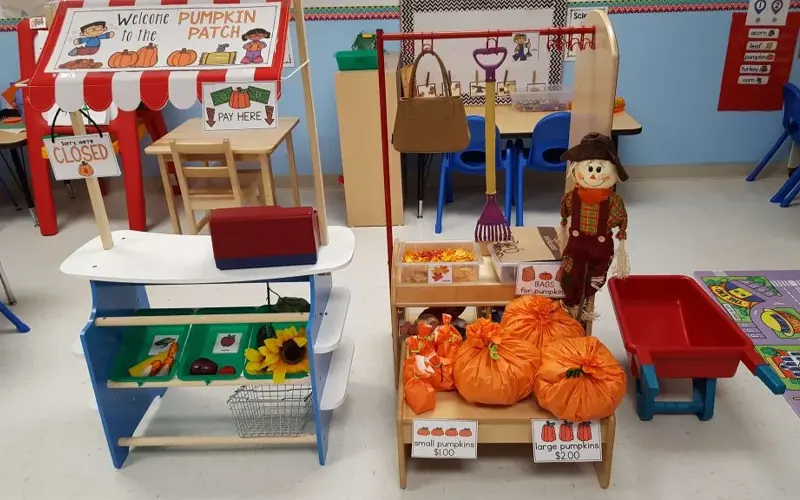
드라마틱 플레이 공간
극적 연극 사회성과 인지 능력을 향상시킵니다. 가상 주방, 미니마켓, 병원 등 어떤 공간이든 소품과 테마 배경은 상상력 넘치는 놀이를 더욱 생동감 있게 만들어 줍니다. 아이들이 즐겁게 놀 수 있도록 공간을 정기적으로 바꿔주세요.
계절별 유치원 교실 장식
유치원 교실을 계절에 맞춰 꾸미면 신선하고, 흥미롭고, 교육적인 분위기를 유지할 수 있습니다. 계절 테마는 아이들이 자연과 교감하고, 주변 세상의 변화를 탐구하며, 특별한 날을 기념하는 데 도움이 됩니다. 봄에는 화사한 꽃으로, 겨울에는 아늑한 눈송이로, 계절에 맞는 유치원 교실 장식은 학습 분위기를 고조시키고 어린 학생들에게 신나는 학습 공간을 만들어 줍니다.
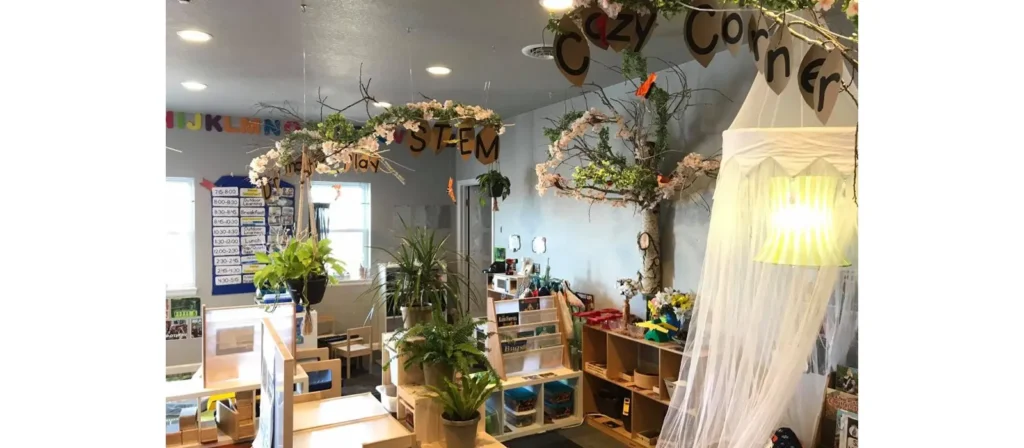
봄 유치원 교실 장식
봄은 새로워지는 계절이므로, 유치원 교실에 신선하고 다채롭고 자연에서 영감을 받은 장식 테마를 도입하기에 완벽한 시기입니다.
- 벽 장식: 생동감 넘치는 분위기를 조성하려면 나비 모형, 꽃 화환, 무지개 배너와 같은 미취학 아동용 교실 벽 장식을 사용하세요.
- 교실 문 장식: 유치원 교실 문을 장식하는 아이디어를 생각해 보세요. 예를 들어, 종이 꽃과 꽃잎으로 학생 이름을 넣은 "성장하는 정원" 문을 만들어 보세요.
- 천장 장식: 종이 구름, 빗방울, 햇살 등의 장식을 걸면 공간이 밝고 통풍이 잘 되는 느낌을 줍니다.
- 활동 코너: 유치원 교실 장식 아이디어와 정원 테마를 접목하여 아이들이 작은 식물이나 허브를 키울 수 있는 식물 심기 공간을 만들어 보세요.
- 인쇄 가능한 장식: 봄 테마의 알파벳 포스터와 자연 기반 학습 차트와 같은 인쇄 가능한 자료를 사용하여 미취학 아동 교실을 장식하세요.
여름 유치원 교실 장식
여름 교실 장식은 따뜻함, 모험심, 그리고 즐거운 야외 활동을 반영해야 합니다. 유치원 여름 교실 장식 아이디어에는 해변, 바다, 캠핑 테마가 포함되는 경우가 많습니다.
- 벽 장식: 유치원 교실의 벽 장식에 바다 파도, 물고기, 조개껍질을 넣어 수중 세계를 만들어 보세요.
- 테마별 교실 장식: 사용 유치원 교실 테마 장난기 넘치는 분위기를 연출하기 위해 해변공, 모래성, 선글라스 등을 이용한 장식이 돋보입니다.
- 교실 창문: 다채로운 태양 데칼이나 손자국 아트를 추가하여 유치원 교실 창문 장식을 밝게 만들어 보세요.
- DIY 장식: 종이 부채, 연, 풍차를 만들어 유치원 교실을 DIY로 장식해 보세요.
가을 유치원 교실 장식
가을 장식은 따뜻한 분위기, 수확 테마, 그리고 계절의 축하 분위기를 자아냅니다. 유치원 교실의 가을 장식은 호박, 나뭇잎, 그리고 숲 속 생물들을 중심으로 하는 경우가 많습니다.
- 벽 및 게시판: 낙엽, 허수아비, 아늑한 가을 풍경을 활용한 미취학 아동 교실 벽 장식 아이디어를 활용해 보세요.
- 교실 문: 유치원생을 위한 가을 교실 문 장식 아이디어로 창의력을 발휘해 보세요. 예를 들어, 호박에 각 학생의 이름을 적은 "호박 패치"를 만들어 보세요.
- 매달린 장식: 유치원 교실 천장 장식에는 가을 단풍, 도토리, 올빼미 등을 사용할 수 있습니다.
- 대화형 요소: 아이들이 감사하는 글을 적을 수 있는 감사나무는 미취학 아동 교실을 장식하기에 좋은 아이디어입니다.
겨울 유치원 교실 장식
겨울 테마는 눈송이, 장갑, 그리고 축제 분위기의 장식으로 아늑하고 마법 같은 학습 환경을 조성합니다. 미취학 아동 교실을 위한 겨울 장식은 아이들이 겨울 날씨와 명절에 대해 배우는 데 흥미를 더해 줍니다.
- 벽 및 창문 장식: 눈송이 모양, 고드름 화환, 겨울 동물 등 유치원 교실의 겨울 장식을 활용하세요.
- 교실 문: 미취학 아동을 위한 겨울 교실 문 장식 아이디어에는 눈사람과 썰매 타는 장면이 있는 "겨울 원더랜드" 테마가 포함됩니다.
- 천장 장식: 축제 분위기를 연출하려면 면 눈송이나 부드러운 전구를 걸어보세요.
- 감각 영역: 가짜 눈과 겨울 동물 인형이 들어간 눈 테마의 감각 상자는 미취학 아동을 위한 교실 장식 테마를 향상시킵니다.
휴일 유치원 교실 장식
명절 장식은 유치원 교실을 축제 분위기와 흥미진진함으로 가득 채웁니다. 할로윈, 추수감사절, 크리스마스 등 어떤 명절이든, 유치원 교실 장식은 아이들이 문화적 전통을 이해하는 데 도움이 되는 동시에 공간에 따뜻함과 재미를 더합니다.
유치원 할로윈 교실 장식
할로윈 장식은 교실에 으스스하고 재미있는 분위기를 더합니다. 유치원 교실 할로윈 장식은 재미있으면서도 너무 무섭지 않아야 합니다.

- 벽 장식: 유치원 교실에 친절한 유령, 호박, 박쥐와 같은 장식을 활용하세요.
- 교실 문: 미취학 아동 교실 문 장식 아이디어에는 "친절한 괴물"이나 "호박밭" 테마를 포함할 수 있습니다.
- 인터랙티브 데코: "트릭 오어 트릿" 카운트 보드는 학습을 강화하는 동시에 교실 미취학 아동을 위한 장식의 일부가 될 수 있습니다.
- DIY 공예품: 아이들이 종이로 만든 호박등과 거미줄을 이용해 교실을 장식하도록 격려하세요.
추수감사절 유치원 교실 장식
추수감사절 장식은 감사, 수확, 그리고 함께하는 시간에 초점을 맞춥니다. 유치원 교실을 추수감사절 분위기로 꾸미는 데에는 따뜻한 가을빛과 테마 요소를 포함할 수 있습니다.

- 벽 및 게시판: 학생들이 만든 감사의 잎사귀로 감사를 표현하는 "감사 나무"는 유치원 교실 벽을 장식하기에 좋습니다.
- 교실 문 장식: 유치원 교실 문을 칠면조 모양에 학생들의 손자국을 깃털로 장식하여 개인적인 느낌을 더했습니다.
- 테이블 장식: 종이 호박, 풍요의 뿔, 가을 화환과 같은 유치원 교실용 요소를 장식으로 활용하세요.
유치원 크리스마스 교실 장식
크리스마스 장식은 유치원 환경에 기쁨과 따뜻함을 더합니다. 유치원 크리스마스 교실 장식은 명절 색상, 축제 분위기의 캐릭터, 그리고 아늑한 겨울 테마를 활용할 수 있습니다.
인쇄 가능한 장식: 유치원 교실 장식을 인쇄할 수 있는 휴일 테마의 알파벳 차트와 숫자 포스터는 축제적인 학습 분위기를 더해줍니다.
벽 및 천장 장식: 눈송이, 크리스마스 트리, 반짝이는 전구 등 크리스마스 장식을 미취학 아동 교실에 활용하세요.
교실 문: 미취학 아동 교실 문 장식 아이디어에는 "산타의 작업장"이나 "진저브레드 하우스" 테마가 포함됩니다.
크리스마스 공예 코너: 유치원 크리스마스 교실 장식 아이디어에는 DIY 장식품 만들기 스테이션을 포함할 수 있습니다.
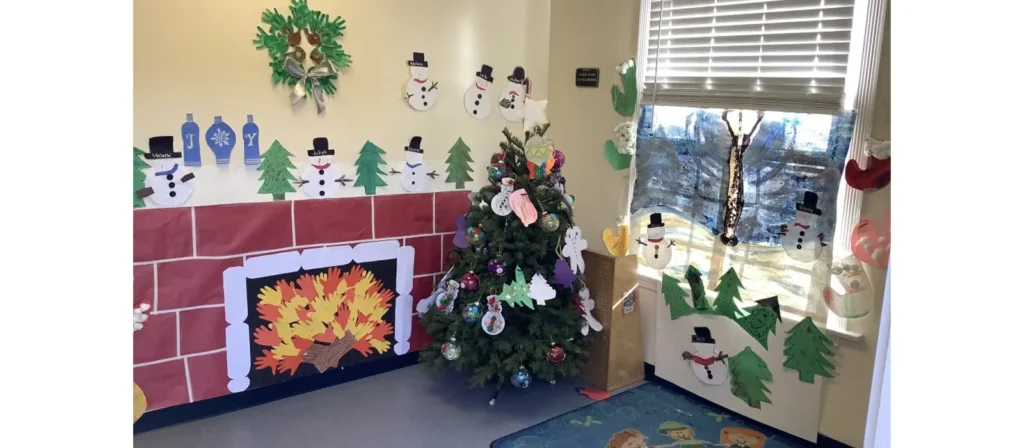
결론
유치원 교실 장식은 어린아이들의 학습 경험을 형성하는 데 중요한 역할을 합니다. 잘 꾸며진 교실은 시각적 자극을 제공하고, 상호작용을 촉진하며, 창의력을 키워줍니다. 교사는 주제를 신중하게 선택하고, 상호작용 요소를 활용하며, 계절과 명절 장식을 활용함으로써 역동적이고 몰입도 높은 학습 환경을 조성할 수 있습니다.
상호작용형 게시판부터 자연에서 영감을 받은 장식까지, 교실의 모든 요소는 학습에 도움이 되는 동시에 공간을 편안하고 즐겁게 만들어 주어야 합니다. 장식은 기능적이면서도 재미있어야 하며, 아이들이 유치원 교실에 발을 디딜 때마다 영감을 느낄 수 있도록 해야 합니다.
교사는 지속적으로 학습 환경을 새롭게 함으로써 학생들이 학습에 대한 흥미와 참여를 유지할 수 있으며, 이를 통해 평생 호기심과 창의성을 발휘할 수 있는 토대를 마련할 수 있습니다.




